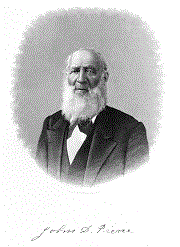Legislator Details

Portrait of John Davis Pierce scanned from Rep.Dist. 2 page previous to p.61.
Vital Records Information:
Marital Information:
Married Miss Millicent Estabrook of Holden, MA on February 1, 1825 and he buried her exactly two years later. Married Mary Ann Cleveland (daughter of General Erastus Cleveland, of Madison, NY) on October 28, 1829 and she died in 1823 during the cholera scourge. They had two children, a daughter that died at age 14, and a son that died in early manhood of disease contracted while serving with General Scott in the Mexican War. Married Harriet B. Read in 1833 and had two daughters with her.
Number of Children: 4
Background
Education:
Common schools in Worchester, MA (8 weeks of the year), studied Latin under Rev. Enoch Pond, graduated in the first 8 of his class at Brown University in 1822, and graduated from Princeton Theological Seminary in 1824.
Biographical Sketch:
Son of Gad and Sarah (Davis) Pierce, John Davis Pierce was born in Chesterfield, NH but spent years two to twenty with his uncle in Worcester, MA. After he graduated from Princeton Theological Seminary he was appointed pastor of a church in Oneida County, NY (January 1, 1825), where he stayed for four years until the building issues between the masonic and anti-masonic temperament made him close his pastorate. He received a call from the Home Missionary Society to settle as a missionary in Michigan or Chicago, IL. He chose Marshall, MI in July of 1831 and moved his family there the next year. He continued as a missionary until July 26, 1836 when he was appointed to Superintendent of Public Instruction. After his plan was accepted he went back to missionary work until elected to the state Senate. He spent the rest of his years vying between political and ministry work. He supported education for all, the homestead exemption law, and opposed slavery.
Notable Facts:
Rev. Pierce was principal for a year at Wrentham Academy in MA (1822-1823) and an academy in Goshen, CT (1829-1830). His plan set up how public schools in Michigan would work, and was accepted almost unanimously, with very few amendments.
